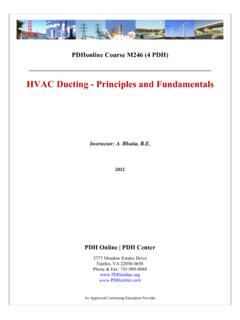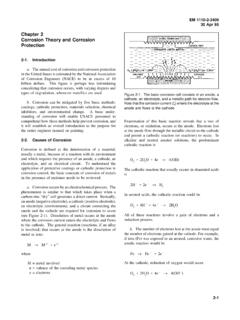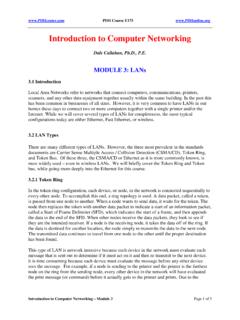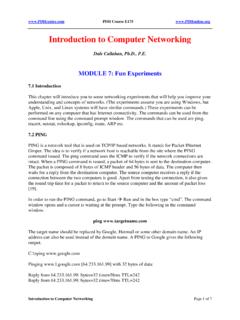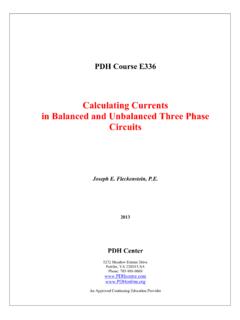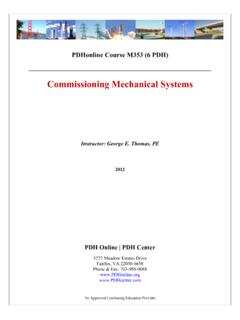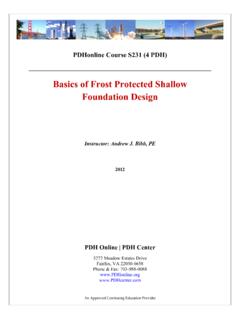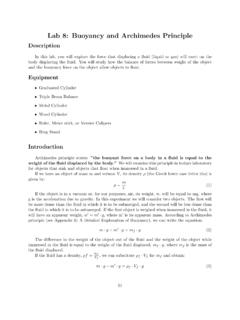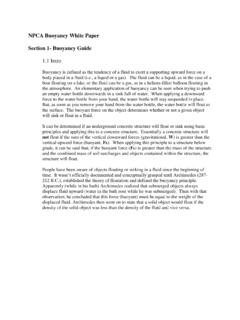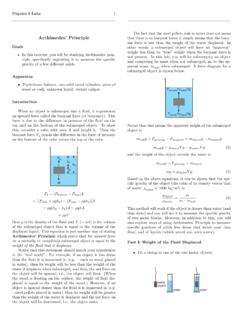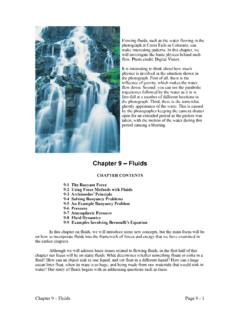Transcription of The Law of Buoyancy - PDHonline.com
1 An Approved Continuing Education Provider PDHonline Course C676 (1 PDH) The Law of Buoyancy Ruben A. Gomez, 2013 PDH Online | PDH Center 5272 Meadow Estates Drive Fairfax, VA 22030-6658 Phone & Fax: 703-988-0088 PDHonline Course C676 2013 Ruben Gomez Page 2 of 21 The Law of Buoyancy Ruben A. Gomez, PREFACE When it came to shipbuilding, there was a generalized belief until a few centuries before Christ, that if a certain material had the quality of floating on the water, that would qualify it as a desirable material for boat building. Conversely, a material that would not float was worthless in the minds of the boat builders.
2 Consequently, wood was decidedly considered the ideal material for such purpose. On that same line of thought, nobody from that era would consider any of the known metals and minerals of the time to be any suitable, for they did not float. It was not until and after archimedes discovery in about 250 BC, that the ancient man figured that the material did not matter as originally perceived, since flotation was rather controlled and determined by the factors of volume and density. Yet, for hundreds of years after that they continued to use wood for several other reasons, such as availability, technology, workability, proper tools and their own self-assurance. On the other hand, needs such as size, hermeticity, strength and requirements from the art of war brought out the reality of having to consider other more efficient materials such as steel, aluminum, fiberglass and even wire-reinforced concrete (this latter material has been known for nearly one-hundred years by its coined Italian name of ferro-cemento) as part of the boat building industry.
3 THE PRINCIPLE OF archimedes The Law of Buoyancy , or by another name, The Law of Flotation, is what the Principle of archimedes is also called for and known as. archimedes discovery came to change the generalized common perception of flotation that had existed from the beginning of man s development. As far as history goes, the Greek philosopher and mathematician archimedes sometime around the third century BC is credited with the observation that led to the principle named after him. King Hieros of Syracuse had decided he needed a new gold crown with a revised design deserving of his achievements. For that purpose he commissioned a goldsmith named Niarchos for the task of melting his crown for the gold and recast it under his new approved design. When the new crown was finished and delivered to the king, he felt that the crown was somewhat lighter as if Niarchos had cheated by alloying the gold with other cheaper metals and had kept the difference in value, in addition to his fee for the work.
4 King Hieros asked archimedes to make the determination without damaging the crown. archimedes was perplexed, although he knew that by the goldsmith having mixed the PDHonline Course C676 2013 Ruben Gomez Page 3 of 21 pure gold of the crown with another precious or semi-precious metal, it should have resulted in a reduced density which was the point he needed to prove. Further, he also knew well the consequence of his findings and how it would affect the fate of the goldsmith. Yet, he had no idea of how to prove it in a decidedly and conclusive manner. He needed both weight and volume for such a purpose and while he could easily obtain the exact weight, he could not determine the volume of such intricately conceived object.
5 Suddenly one day, as archimedes submerged himself into a water filled bathtub to take a bath, he was stunned by observing how as he lowered himself into the tub the displaced water overflowed over the sides. All of the sudden the answer dawned on him. He ran naked (as the storytelling goes) through the streets of Syracuse shouting: Eureka, I have got it! Right then and there the archimedes Principle was born! The rest was easy, first he weighed the crown as accurately as the methodology of the time permitted, and then, as he immersed the crown in a pail of water, he measured the rise in water level. As a third step, he took a bar of solid gold of equal weight and repeated the experiment and found that there was a reduced density in the gold crown. That was a conclusive proof and evidence that Niarchos had cheated and therefore, had to endure the consequences of his dishonest act.
6 The Principle of archimedes in all its wisdom predicates that: when a body is submerged in a liquid, it receives an upward force equal to the weight of liquid displaced. Such an upward force exerted by liquids against their submerged objects, is in fact the phenomenon so called Buoyancy . It took nearly two thousand years for the next needed principle to couple with the Law of Buoyancy , so as to bring practical use and to inject life of its own to the science of Hydraulics. French mathematician Blaise Pascal (1623-1662 AD), after a lot of trial and error experimenting is when he conceived what is now known as the Pascal s Principle. This principle can be expressed as follows: Pressure exerted anywhere in a confined liquid is transmitted unchanged to every portion of the interior and to all the walls of the containing vessel; and such pressure is always exerted at right angles to such walls.
7 We can reason here that since all liquids will flow in response to an applied force; therefore, any given force will be transmitted through the liquid in a form of constant pressure acting against all surfaces of the container or vessel. By using such principle we can take advantage of liquid pressure in the same manner as we have used the lever. archimedes PRINCIPLE EXPRESSED IN MATHEMATICAL FORM The weight of a solid or liquid body (W) is equal to its volume (V) multiplied by the density (D) of the material it is made of, in other words: W = V . D Referring now to the contents of Figure where we show a certain container filled up PDHonline Course C676 2013 Ruben Gomez Page 4 of 21 with water (could be any other liquid for that matter) and a submerged body subject to different material densities and/or interior characteristics.
8 These are the governing parameters: W1 = weight of the submerged body W2 = weight of displaced liquid V1 = volume of the submerged body D1 = density of the submerged body (a variable) V2 = volume of the displaced liquid (as a function of W1) D2 = density of the displaced liquid (a constant) Therefore: W1 = V1 . D1 (out of the water) or, W1 = V1 . D1 - V2 . D2 (when submerged) We can now place archimedes original idea in a mathematical form and find D1 this way: D1 = [W1 + (V2 . D2 )]/V1 Figure also reflects the fact that for flotation to take place, the weight of liquid displaced must be equal of larger than the weight of the submerged body. Although archimedes never had the opportunity to experiment with the effect of temperature fluctuations on the density of fluids, we now know that not only density varies from liquid to liquid, but also that temperature changes tend to affect density and therefore, volumetric changes within the same liquid.
9 Enclosed Figure (as well as Table ) show those variations particularly applied to fresh water. Temperatures have been shown within a spectrum from 25 to 200 degrees Fahrenheit, with the maximum attainable density occurring at 39 deg F. Further, it must be stated here that diluted sodium chloride (salt) as it is the case in sea water, acts as temperature retardant and volume stabilizer. PDHonline Course C676 2013 Ruben Gomez Page 5 of 21 PDHonline Course C676 2013 Ruben Gomez Page 6 of 21 PDHonline Course C676 2013 Ruben Gomez Page 7 of 21 TABLE * Density of different liquids Liquid Temperature (Deg.)
10 F) Density (lbs/CF) Remarks Pure Alcohol Mineral Oils Vegetable Oils Freezing Fresh Water About 25 Fresh Water 32 Fresh Water 39 Max. attainable density. Fresh Water 50 Fresh Water 70 Fresh Water 100 62 Fresh Water 200 60 Brackish Water 63 As in the Biscayne Canal. Sea Water 64 *Above values have been directly reproduced, or either derived or interpolated from sources such as: Standard Density Tables of the Bureau of Standards and the ASCE Manual for Hydraulic Studies. In the case of a steel barge, as in the example we will have the opportunity to examine at the end of this course, although the density of the steel was a lot greater than that of water, it still floated because said barge was hollow and therefore capable of displacing a large volume of water, which weight was considerably larger than the weight of the steel hull plus the payload.
